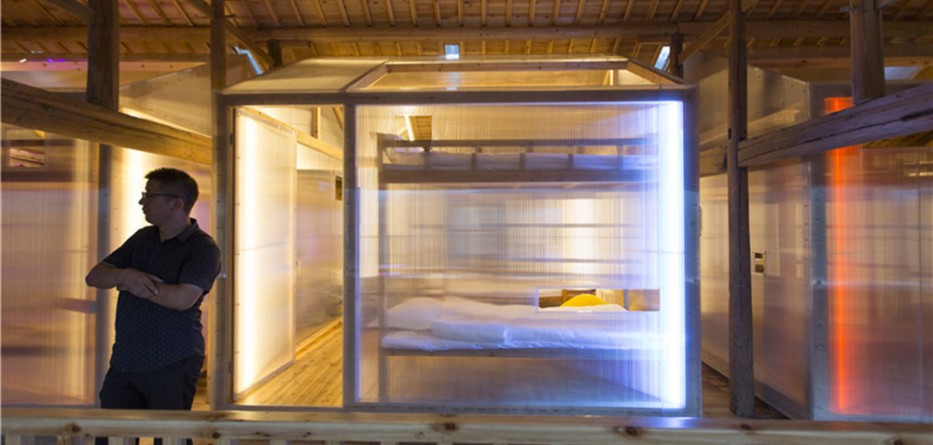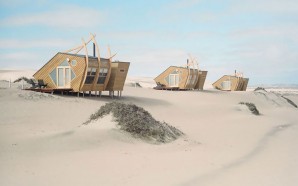he wei adds lightweight, translucent, removable structures to chinese hostel
(above) the rooms follow the ‘space within a space’ concept and can accommodate up to 6 people
all images courtesy of he wei and chen long
architect he wei has renovated the inside of an old keekwilee-house and has transformed it into ‘papa’s hostel’ in pingtain village, china. the building was an ordinary rammed earth dwelling with a total of 270 square meters divided into two floors. the town inhabitants used to call the place ‘papa’s home’ since it was the home of an elderly man called jiang binlong. the aim of the design was to give the architecture new functions and spaces, giving it a fresh young face—a youth hostel with international standards.

the ground floor provides the guests with recreational space
to maintain the overall style and features of the village, the exterior of ‘papa’s home’ has been kept almost unchanged.only a window has been added in the second floor to allow natural light and air to flow into the house. on the contrary, the interior received bold changes, including the divisions on the first floor, transforming it into one big open space. this one will be used as a social area for the guests, tourists, and villagers.

lightweight, translucent, removable structures serve as the rooms
as for the second floor, the team intended to keep the original characteristics of the spacious room, avoiding the conventional method of using fixed walls to divide it. the concept of ‘space within a space’ was implemented, adding gable-shaped structures that serve as the guestrooms. made of lightweight materials which are dismountable, portable and translucent, the ‘houses within a house’ were installed, adding a gentle feeling. these little structures function as the rooms of the hotel, hosting up to 6 people. the semi-hollow sheets that are used as diving walls result in a blurred effect that highlights the construction character, compared to the original hard materials.
the space atmosphere changes as the color lights illuminate
light was an important element of the design, placing soft LED sources along the wooden framework, highlighting the natural materials and adding an artistic expression. the illumination is reflected and refracted by the semi-transparent materials to light up the whole space. changing shadows offer people a sweet, vague, and elusive feeling. colorful lights can also be used, transforming the space into a vibrant and young one.

the original closed wall has been transformed into a long horizontal window with a view

transparent and translucent

the staircase

young guests in the rooms

light belts and structure of the houses
‘papa’s hostel’ in the village after renovation

floor plan

section
project info:
project name: papa’s hostel
location: pingtian village, sidu township,songyang county, lishui city, zhejiang province, china
client: jiang bin-long (a local villager from pingtian village)
chaired architect: he wei
architectural design team: chen long, li qiang, chen huang-jie, cheuk chun-yung
lighting design team: zhang xin, han xiao-wei, zhouxuan-yu
design year: 2014-2015
completion time: 2015.09
area: 270 square meters
cost of construction: rmb 200, 000
photographer: he wei, chen long
Source: designboom.com









